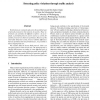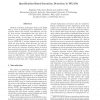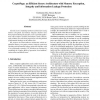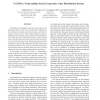109
Voted
ACSAC
2006
IEEE
15 years 4 months ago
2006
IEEE
Active worms pose major security threats to the Internet. In this paper, we investigate a new class of active worms, i.e., Camouflaging Worm (C-Worm in short). The C-Worm has the ...
78
Voted
ACSAC
2006
IEEE
15 years 4 months ago
2006
IEEE
Signature-matching Intrusion Detection Systems can experience significant decreases in performance when the load on the IDS-host increases. We propose a solution that off-loads so...
112
Voted
ACSAC
2006
IEEE
15 years 4 months ago
2006
IEEE
Restrictions are commonly placed on the permitted uses of network protocols in the interests of security. These restrictions can sometimes be difficult to enforce. As an example, ...
126
Voted
ACSAC
2006
IEEE
15 years 4 months ago
2006
IEEE
When an application reads private / sensitive information and subsequently communicates on an output channel such as a public file or a network connection, how can we ensure that ...
104
Voted
ACSAC
2006
IEEE
15 years 4 months ago
2006
IEEE
Wireless networking technologies based on the IEEE 802.11 series of standards fail to authenticate management frames and network card addresses and suffer from serious vulnerabili...
99
Voted
ACSAC
2006
IEEE
15 years 4 months ago
2006
IEEE
Several secure computing hardware architectures using memory encryption and memory integrity checkers have been proposed during the past few years to provide applications with a t...
135
Voted
ACSAC
2006
IEEE
15 years 6 months ago
2006
IEEE
The efficiency of promptly releasing security alerts of established analysis centers has been greatly challenged by the continuous emergence of various large scale network attack...
93
Voted
ACSAC
2006
IEEE
15 years 6 months ago
2006
IEEE
Information leakage through covert channels and side channels is becoming a serious problem, especially when these are enhanced by modern processor architecture features. We show ...
101
Voted
ACSAC
2006
IEEE
15 years 6 months ago
2006
IEEE
We present NetSpy, a tool to automatically generate network-level signatures for spyware. NetSpy determines whether an untrusted program is spyware by correlating user input with ...
95
Voted
ACSAC
2006
IEEE
15 years 6 months ago
2006
IEEE
Performing sensitive online transactions using computers found in cybercaf´es and public libraries is risky. The untrusted nature of these machines creates a target rich environm...




